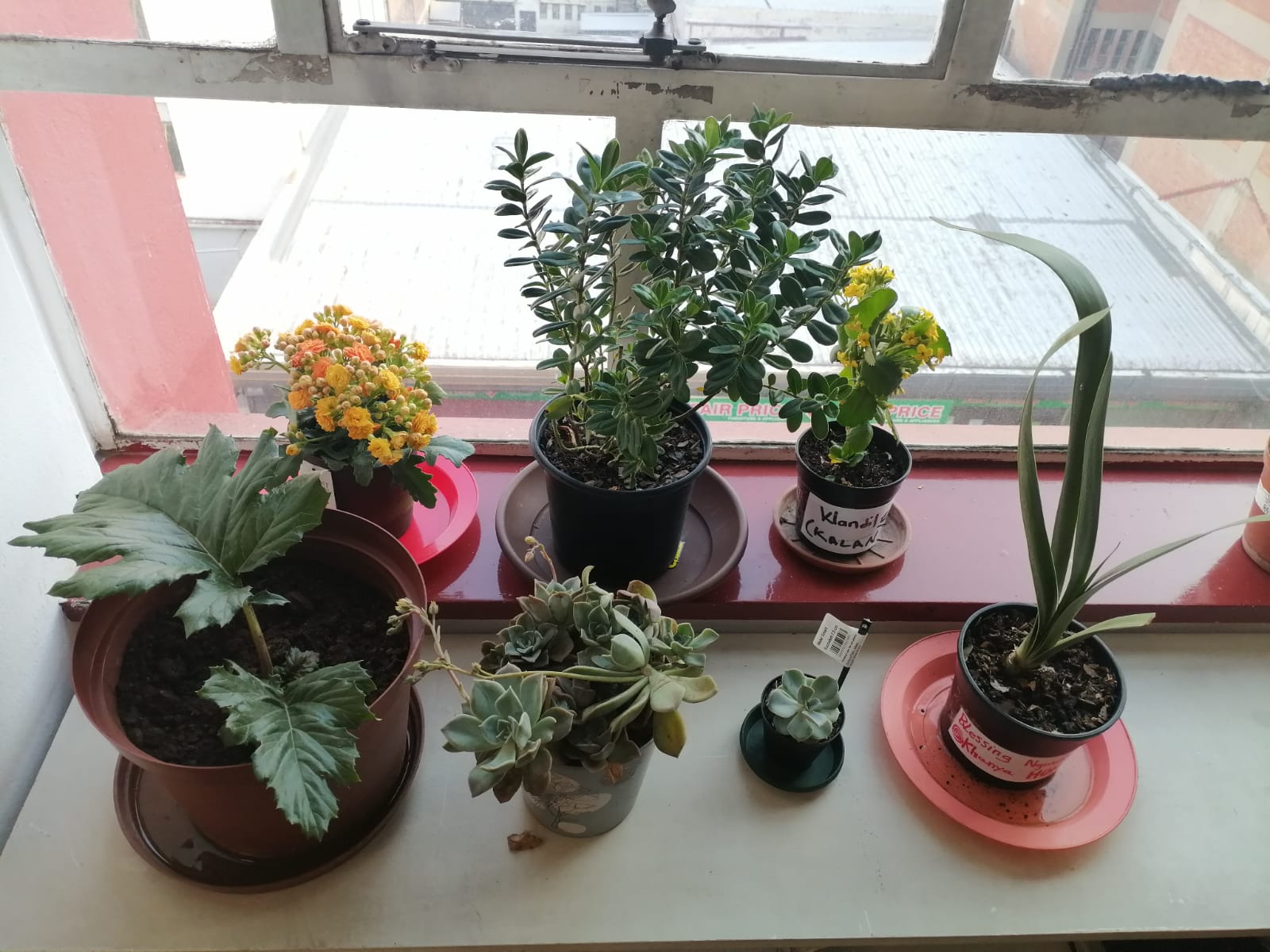Staff at Khanya College have taken up an interesting challenge, if you want, to care for plants. Each plant is of an individual’s choosing. Of course, managing plants is a good exercise with a variety of benefits related to management.
Other than developing such skills, plants themselves offer a range of benefits to their benefactors in exchange for diligent care. Because plants are of course different, as well all know, we explore the range of the qualities of the plants the members of staff.
Last week, when staff at Khanya College brought their plant pots, the choices seemed to show an acute awareness that one needs some level of know-how and perhaps expertise to properly care for any kind of vegetation as succulents are proving popular. There are also some little exotic choices as well as plants that will grow to become shrubs of over a metre tall, adding height to the greenery serving as part of the decor arrangement at the foyer.
Apart from concerns about the intricacies of plant and garden management, the choice of succulents is quite astute in the context of a water crisis both in Johannesburg specifically and South Africa generally. The succulent plant formally known as Kalanchoe calandiva is a drought-resistant plant and easy to care for because it can survive neglect, say at a time when the College is quite busy, with the upcoming Jozi Book Fair festival between 18–20 October 2024.
This plant also offers a range of health benefits including its ability to help purify the air of pollutants such as “formaldehyde and benzene”, according to some sources. Calandiva plants are linked to stress relief and if in the home, can help improve sleep. Other benefits include pest control and medicinal properties working against inflammation, for example.
The other succulent species in the foyer is the ghost plant, formally the echeveria domingo. This plant also requires lesser amounts of water and can tolerate a break in care. In many ways, echeveria succulents offer similar benefits to the calandiva, but a unique quality associated with the echeveria is part of its medicinal effect as it can help treat warts, making it easy to remove them.
Demanding a little bit more than the ghost plant and calandiva is the ‘Hebe Blue Boy’, native to New Zealand, South Africa and New Guinea. It is an evergreen shrub that does well in semi-shade but will take some sun. Its water needs are also moderate. Many gardeners like this shrub for its visual effect helping to enhance gardens. It also boasts benefits practical and health benefits.
Mbali Sithole who is participating in the challenge and brought a kalanchoe calandiva plant told Karibu, “The reason behind me choosing it was because, firstly, it looked very beautiful to me. Also, the price was reasonable. It has beautiful yellow and orange flowers; it brightens up the room. I don’t know much about flowers and growing them. For the beautiful flower it is, it doesn’t need much attention and you only water it once a week.”
Her succulent is already blooming, just like a few others, while some plants are still young and will need care and management until they bloom as well.
The final two plants in the foyer are the bear’s breeches (acanthus mollis) and a bulb, the amaryllis. The bear’s breeches are of course another visual stunner with strikingly shaped leaves. They are semi-evergreen but are herbs that cannot stand too much sun, this has already been a lesson learned at Khanya, now that the plant has recovered and enjoying proper care. It has very good medicinal value, able to help soothe burns and to treat mucous membranes internally, through ingestion.
“I chose this plant because of its green hard leaves which symbolise that it can survive hard temperatures,” noted Yonela Gebengu, who cares for the bear’s breeches, before continuing to say, “having to care for a plant symbolises your own behaviour and how you treat nature, and by the way it grows and is taken care of also can show how responsible you are as a person.”
Amaryllis is also another plant with good tolerance levels and demanding little watering. They also over air improvement and are part of traditional medicine in South Africa where they grow natively, in parts of the Western Cape.
All the plants chosen by Khanya staff are quite tolerant of droughts, they can be potted and require soils that are easy to reproduce and maintain, even by beginners in plant care.
“The Plant Exercise to me is a challenge to see how good we as comrades are with taking care of the things around us, this is simply to find out how aware we are with the things that affect our surroundings. said staff member, Wandile Mchunu.
The future is quite colourful as these plants are expected to bloom in the coming months and should produce stunning visual effects to uplift both the feel and the look of the foyer and the office space as well.
The exercise itself should help to encourage cohesion among the team, although it is already high, and well-being too. it will encourage collaboration. A community is growing while tendering to plants together. New conversations about dealing with any challenges will take place.
This article was submitted on 02 October 2024. You may republish this article, so long as you credit the authors and Karibu! Online (www.Karibu.org.za), and do not change the text. Please include a link back to the original article.


 Download PDF
Download PDF